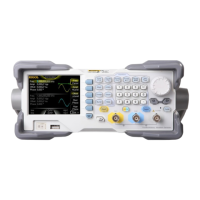Chapter 2 Front Panel Operations RIGOL
DG1000Z User’s Guide 2-17
To Output Arbitrary Waveform
DG1000Z can output built-in or user-defined arbitrary waveforms from a single
channel or from two channels at the same time. The 160 kinds of built-in arbitrary
waveforms are stored in the internal non-volatile memory. DG1000Z provides 2Mpts
(2M data points, applied to DG1022Z) standard memory depth, 8Mpts (8M data
points, applied to DG1032Z and DG1062Z) standard memory depth and a 16Mpts
memory depth option for user-defined arbitrary waveforms. When editing the
waveform on the instrument, 8pts to 8kpts data points are available in period editing
mode and 8pts to 16kpts data points are available in sample rate editing mode. The
waveforms edited can be stored in the internal or external memory (in *.RAF format)
of the instrument. When the number of waveform points is greater than 8kpts (in
period mode) or 16kpts (in sample rate mode), users can edit the waveform via the
PC software; download the waveform to the instrument via the remote interface; or
store the waveform in a USB storage device and then read and output the waveform
via the instrument.
To Enable Arbitrary Waveform
Press Arb to enable arbitrary waveform function and open the operation menu of
arbitrary waveform.
1. Freq/Period: set the output Frequency/Period of the arbitrary waveform. This
menu is only displayed when the frequency output mode is selected.
2. Sample Rate: set the output Sample Rate of the arbitrary waveform. This menu
is only displayed when the sample rate output mode is selected.
3. Ampl/HiLevel: set the Amplitude/High Level of the arbitrary waveform.
4. Offset/LoLevel: set the Offset/Low Level of the arbitrary waveform.
5. Start Phase: set the Start Phase of the arbitrary waveform.
6. Align Phase: refer to “Align Phase”.
7. Arb Mode: switch the arbitrary waveform output mode between “Frequency”
and “Sample Rate”.
8. Select Wform: select DC, the built-in arbitrary waveforms, the arbitrary
waveforms stored in internal or external memory or the volatile waveform.
9. Edit Wform: edit the selected waveform of the current channel or create a new
waveform.

